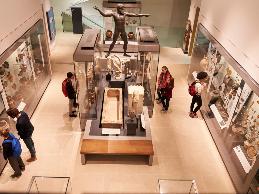The following situations and solutions are real-life examples of accommodations that were made by JAN customers. Because accommodations are made on a case-by-case basis, these examples may not be effective for every workplace but give you an idea about the types of accommodations that are possible.

A large metropolitan police department employed a records specialist who was finding it increasingly difficult to complete the essential functions of his position.
The increase in violent crime over the last several years had taken a toll on the employee, causing increased anxiety, stress, and emotional breakdowns. Attendance was also becoming an issue. When the employee discussed his options for reasonable accommodation with his supervisor, he was pleased to discover several open positions he was qualified for that would take him out of the particular area that was causing his mental health condition to deteriorate.

A food service worker with an anxiety disorder works in the kitchen of a restaurant, helping with food preparation and cleaning.
She is able to perform all of her essential functions, but she tends to talk to her co-workers incessantly about her personal issues to the point that other employees complain to management. A manager talks with the food service worker about her conduct and explains that it is interfering with work and making coworkers uncomfortable. The employee is a client of a mental health agency and offers to talk with her service coordinator about getting a job coach. The job coach teaches the employee how to talk with coworkers about impersonal topics (like the weather) and how to focus conversations on work tasks she and coworkers are performing. The job coach then helps the employee apply the new skills directly on the job and is able to fade out direct involvement after a couple of months.

Phillipe travels in person to the HR department of a prospective employer in order to pick up an application for employment to take home and complete.
He is told that the application cannot leave the building. Phillipe may need to disclose and ask for a change in policy as an accommodation if the employer does not have an online application process that could be completed at home. Phillipe feels that his anxiety level will escalate and be disruptive to the process if he is required to complete the application in the office setting.

A postal employee with PTSD requested accommodations to help him deal with recurring flashbacks.
His flashbacks were triggered by the smell of gasoline and the noise from the mail truck. The employee tried wearing a respirator to give him a clean air supply. He also tried wearing headphones to reduce the noise from the truck, but he still experienced stress and edginess. JAN suggested a position transfer as an accommodation. JAN also suggested allowing this employee to take a break when he experiences extreme anxiety and allow him to use relaxation and visualization techniques in a private space on the job.

Jude, an applicant with a depression and anxiety, is applying for a customer service position that requires a pre-employment test.
Due to medication that Jude takes for both conditions, his processing speed is a bit slower. He feels he can only do his best on the test if he has the accommodations of extended time as well as taking the test in a private location to help limit distractions. In order for the employer to even consider those accommodations, the employee will need to disclose the mental health impairments and be prepared to provide medical documentation.

A driver with seasonal affective disorder (SAD) who picks up and delivers clients to various appointments began to forget waiting clients as well as the routes she needed to travel in order to deliver them to the appropriate facility.
When her employer mentioned the mistakes, the driver broke down. She described her depression and anxiety with the change of seasons and how it affected her memory. The use of reminder apps, as well as those to help with directions, were discussed as possible accommodation solutions.

A secretary with PTSD, who had been carjacked several years earlier, experienced significant anxiety during commutes after dark.
This caused difficulty concentrating and irritability. She was accommodated with the ability to have a support animal at work and a flexible schedule with work from home during periods of minimal sunlight.

A counselor with PTSD needed to use a service dog at work to decrease his anxiety.
Even as a veteran, his employer was concerned about having a dog present when clients were being counseled. The employer allowed the use of the service dog, but provided a separate area for the dog to stay in during counseling sessions with clients.

A customer service representative working in a call center was experiencing limitations associated with generalized anxiety disorder and depression.
He began treatment with a new healthcare provider who adjusted his medications and recommended bi-weekly counseling sessions for one month. He exhausted his accrued paid sick leave but was FMLA eligible. He applied FMLA leave intermittently in order to attend counseling appointments.

A veteran returned to his civilian job as a manager of sales for a small employer.
While in the service, he sustained a TBI. His employer had upgraded the office computer system and the veteran had trouble using the new computer system, causing him stress and anxiety. The employer allowed the veteran time for training to learn the new computer system.

An insurance agency employee with multiple sclerosis and anxiety requested that the employer permit her to use a service dog on the job for mobility and stress reduction.
The employer agreed to allow the employee to bring her service animal to work, provided training to staff on service animals as workplace accommodations, and installed new doors that were easier for the individual to open.

A vocational school teacher with PTSD requested accommodations due to anxiety and flashbacks.
She taught in a building separated from the main school, and she had difficulty dealing with large classrooms of unruly students. As an accommodation, JAN suggested training the teacher on special behavior management techniques and providing administrative support for student disciplinary actions. The school also provided the teacher a two-way radio, which allowed her to contact an administrator quickly when she needed immediate assistance in her classroom.

A professor on the autism spectrum had difficulty keeping daily office hours and experienced anxiety because the timing of students' consultations was unpredictable.
JAN suggested modifying the schedule as an accommodation, for example the professor could reduce the number of days he has office hours, but have more office hours on those days. JAN also suggested adjusting the method by which students obtain appointments, asking students to schedule at least one day in advance and when possible, allow the professor to conduct consultations electronically, by phone, or by instant messenger. In addition, JAN suggested documenting each student consultation to ease the professor's anxiety about the meeting and to refresh his memory about previous meetings with the student.

A prison guard, recently attacked by an inmate, has PTSD and anxiety.
The prison guard was fearful of returning to the worksite, even to discuss her return-to-work options. A JAN consultant offered the following suggestions: allow the employee to bring a support person or support animal to the meeting, move the meeting to an alternative location, or allow the employee to attend the meeting via telephone.

An employer was notified that the only supervisor he had in a particular department had a phobia towards a specific group of people.
The supervisor asked to be excused from supervising a new employee from this people group. Since she was the only supervisor in that area, the employer could not remove the duty or give it to another. By attending the meetings himself with the supervisor and this particular employee, the employer was able to reduce the anxiety the supervisor was feeling and eventually enable her to meet with the person (and others) without the extra support.

An employer, trying to accommodate an employee returning to work after a leave, had questions about the stress of required travel that escalated the employee’s depression and anxiety.
The employer was advised to continue on in the interactive process to discover what specifically about the travel was stressful so they could determine accommodations for those identified issues. Examples of questions to ask could include what particularly about the travel causes the stress that heightens the depression, such as the length of the travel, the distance, the planning process, or even specific modes of travel and/or locations.

An administrative assistant with PTSD works at a museum, which is currently under construction.
Construction workers, who were strangers, caused the employee extreme anxiety. As an accommodation, a JAN consultant suggested temporarily relocating the employee’s work space away from the construction area. The museum also developed an ID badge for construction workers and required them to sign in at their job locations.

A retail manager who travels a fair distance in rush hour traffic asked to be reassigned to a location near her home where she could commute on less traveled local roads that would cause her much less anxiety.
Her request was denied because there were no openings in the store closest to her, and her position in her current location was needed there. She was given the choice of a schedule change as an accommodation so that she could arrive slightly before / after the rush hour.

An employee with anxiety and a driving phobia takes public transportation to work.
After a company restructure, the employee was moved to work in a new location that would necessitate a lengthy commute involving two buses and a train. She disclosed her disability and asked for accommodations. She was accommodated by remaining at her current location, with a change in supervisor to the one who would oversee the employees in that location. Although her current supervisor was going to the new location, her job would remain the same.

A veteran who is now an office employee has PTSD and anxiety.
He is easily frightened when being approached unsuspectingly. This employee works in a structured cubicle environment facing his computer and cubicle walls, with his back to the cubicle entrance. He wants to be alerted when a coworker or supervisor walks into the cubicle behind him. JAN suggested using a monitor-mounted mirror, so he could see the entrance behind him. JAN also suggested placing a sensor mat at the entrance of the cubicle, which will make an audible alert when someone steps on it.





















